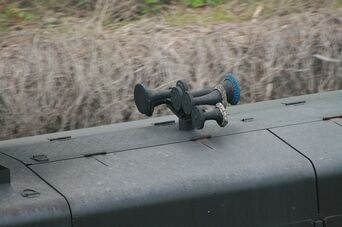Bio[]
The Nathan-Airchime K5LA is a five-chime North American airhorn or train horn commonly used on diesel locomotives, but can often be found on electric locomotives and cab units from EMUs (electric multiple units); such as the AEM-7, and the Acela Express HST trainsets used by Amtrak throughout the Northeast Corridor. The K5LA has been in production since 1976, though the prototypes were produced the previous year in 1975.

An example of a K5LA.
Although popular with eastern carriers throughout the United States (such as CSX and NS), it can commonly be heard and found on various commuter railroads and shortlines. Some can even be heard along the West Coast and throughout the Midwest. Amtrak is the only known regional user, yet some horns can be heard and found on certain units owned or utilized by various other regionals such as Metrolink and GO Transit.
Said horn has had numerous variants or generations produced over the years; most notably the K5LAR24 and the K5LLA used almost exclusively on SD70ACe and SD70M-2 diesel-electric locomotives.
History[]
The lead designer of the K5LA, Deane Ellsworth (an Amtrak manager who soon worked for CSX), originally devised the K5LA to be reminiscent of the M5, while further being an improvement to the P5, and drawing inspiration from the existing K3H and K5H (which were designed under Robert Swanson; lead designer and founder for Nathan-AirChime). Considering how the pitch of the later P Series horns dropped and wavered in tone significantly worse than its predecessors, an updated "kettle drum" design (reminiscent of the Canadian-tuned K3H and K5H) was conceived to rectify the problem with the flawed design of the existing horn models produced at the time. Thus, the K5LA was born.
The horn was originally designed for use on Amtrak by Ellsworth (who had previously designed horns such as the P5a), and was first manufactured in 1975 as a replacement for the two-piece, four-chime Leslie SL-4T, which often fouled easily and created noise pollution for people who lived in nearby homes. Despite having been designed for said passenger railroad corporation, it was first utilized by Chessie System (now CSX) on a late order of GP40-2 units along with their subsequent order of early SD50 units. Said horns on such GP40-2 units were sand-casted, preproduction horn units, while the ones produced from 1976 onwards are die-cast (or "new-cast"). Thus, dubbing CSX as the first customer, owner, or user for the horn as opposed to Amtrak (yet, Amtrak's history tends to contradict and debate this). As of today, however, both CSX and Amtrak (besides NS) are the main companies whom use the horn. Others include KCS (Kansas City Southern), GO Transit, Metrolink, Metra, among many others.
Specifications[]
The horn consists of having five "bells", which are the actual horns that are connected and pieced together on a manifold to create a distinct harmonic tune or sound to avoid confusion between automobiles and other vehicles (unlike early single-chime airhorns like the Leslie A-200). Each bell is consisted of one individual note, which further gives the entire horn its distinct sound:
- The tuning of the notes are consisted in B major 6th: D#, F#, G#, B, and D#.

A K5LAR24 as-seen on an NS Dash 9, with protective covers preventing dust, birds, insects, and other small obstructions from entering the bells of the horn.
- The horn uses the K-series #1, 2, 3a, 4a, and 5 bells.
- Later models (such as the 3rd generation ones) use bells pitched at slightly different levels.
Sound Issues[]
Ironically, like its predecessor, the horn caused many sound pollution issues for residents whom lived in nearby homes. To reduce the noise levels, restrictors, choke fittings, alternate bell arrangements, and screen fittings (or caps) were fitted to help with the persisting problem. And, of course, the K5LA often suffered numerous fouling issues like its predecessor, and such techniques were also made to prevent further damage.
There are also many variants, versions, and configurations of the K5LA to help muffle or reduce the noise created by the horn, such as the K5LAR24, which is a hybrid version or variation of the horn deemed to be more silent than an all-bells-forward variant. The name designation for the K5LAR24, refers to the 2 and 4a bells being reversed. Hence, the "R" and the subsequent "24" suffix.
Trivia/Facts[]
The K5LA was also originally meant to accompany the Canadian-tuned K5H, for the K5LA was meant to be the American-tuned variant of the subsequent horn model. Union Pacific also had several K5LA horns utilized on some of their early shipments of SD70M's in 2001.
The D&RGW (Rio Grande) also had several K5LA horns installed on their SD50 units, for they were built and delivered to CSX specs.
The WP (Western Pacific) had several K5LA horns installed on their later GP40 units as well.
Most earlier CSX GEVO (Evolution Series) units use K5LA horns in-place of their original 1st-generation K5HL horns as a result of having been swapped or retrofitted with horns from their existing Dash 8 units. Furthermore, their Dash 8 units (C40-8 and C40-8W units) now currently have K5HL horns in-place of their original K5LA and K5H horns, while their ES40DC (ES44DC) and subsequent early ES44AC units now have K5H or K5LA horns.
Sources[]
http://atsf.railfan.net/airhorns/k5la.html
http://www.firehouse.com/forums/t84253/
Videos[]

Pan Am Southern OCS Small Chase.MOV

Hear That Lonesome Whistle!
Deane Ellsworth playing horn and whistle notes on a piano.

Nathan K5LA
Sound examples.
